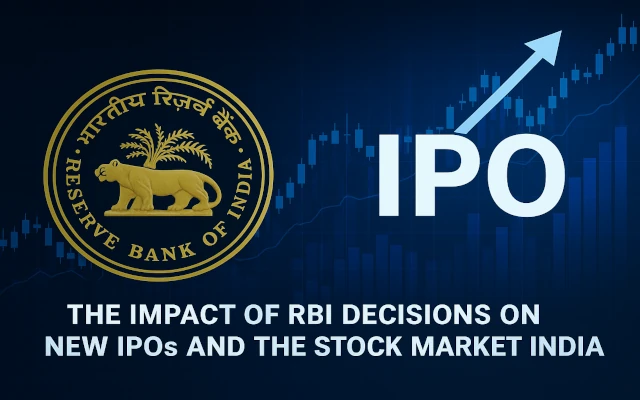By News Karnataka Editorial Team
Copyright newskarnataka

The Indian stock market is currently one of the fastest-developing investment destinations in the world, as domestic and foreign investors are flocking to India. One of the major drivers of the market is the monetary policy and regulatory position of the Reserve Bank of India (RBI).
The RBI’s decisions on interest rates, liquidity, and inflation directly influence investor sentiment, valuations, and the pipeline of new IPO launches.
Since India passes through 2025, investors, issuers and policy formulators need to know the impacts of RBI policies on IPO activity.
The Role of RBI in the Financial Ecosystem
RBI, being the central bank of India, regulates money supply, interest rates and stability in all banks. These levers’ impacts are pretty substantial in capital formation as well as equity investment appetite. Key areas include:
Repo and Reverse Repo Rates: Display business and household borrowing costs.
Liquidity Management: Establishes the ease of flow of capital.
Inflation Targeting: Price stability to long-term market confidence.
Regulatory Supervision: Affects the financial institutions that are significant in the IPO financing and underwriting.
Any policy review, rate reduction or increase is felt in the equity markets and other companies that are intending to issue funds through IPOs.
The Interest Rates and the Sentiment of IPO
Borrowing costs are very sensitive when it comes to IPO valuation. As the RBI assumes a hawkish approach and increases the repo rates, it becomes more costly to borrow for corporates, thus slowing down the growth and dampening the appetite of investors in risk equity.
Case example: The RBI increased rates by 250 basis points during the global surge of inflation in 2022-23. Owing to the highest levels in 2021, IPO fundraising in India declined by almost 56% in 2023.
Reversed trend: On halting the increase or reducing the rates by the RBI, the liquidity will be improved, the valuation will be increased, and the IPO activity will recover. This was observed in late 2023 and early 2024 when the markets came to their senses and firms queued with bigger issue sizes.
In the case of 2025, the RBI’s policy will maintain inflation at its 4% average and growth tentatively. That stability encourages companies to advance new IPO filings.
Liquidity and Confidence
More funds in the banking system are created by using liquidity injections by Open Market Operations or by CRR reductions. The institutional investors, mutual funds and the retail buyers are able to invest in IPOs with increased liquidity easily.
With the unfriendly liquidity environment, investors in the stock market India become picky, as it is not rare to see large, high-profile IPOs pick up and other smaller firms finding it difficult to raise interest.
Digital Push by Retail Investor Participation and RBI
The IPO market in India has witnessed a growth in retail-based investments due to the ease of use through the UPI-based applications. This is enhanced by RBI policies in support of digital payments, financial inclusion, and reducing transaction costs.
According to SEBI data, retail investors subscribed to IPOs over 35 per cent in 2024, five years later than it was 20 to 22 per cent.
Digital-first strategy of the RBI is in line with the government solutions, such as the India Stack, so that even small-ticket investors can join the fray without any hassle.
It is also important that the retail base is growing because RBI stability is even more significant today since millions of investors are responding directly to policy indicators.
Case Study: IPO Trends in RBI Tightening and Relaxation
Tightening Phase (2022 -23): IPO volumes dropped to their lowest levels, as inflation stood at about 7 per cent, and repo rates have increased. Only a handful of mega-offering companies garnered attention, and even there, listing gains were not robust.
Easing Phase and Stability (2024): With inflation reduced, the RBI stopped the increases, and confidence was restored. Renewable energy, tech, and consumer goods all had successful IPOs of the year, which showed a positive investor sentiment.
This stable macroeconomic environment is likely to improve fundraising conditions, with analysts estimating IPO collections could cross crores in 2025.
How RBI Decisions Affect Various Sectors
The various industries react differently to changes in monetary policies:
Banking and Financials: The sensitivity to rate is high; the IPO boosts when the economy is in the easing process.
Tech & Startups: Rely on the availability of liquidity and risk willingness by the investors.
Manufacturing and Infrastructure: The movements of interest rates determine the financing of expansion, which influences the timing of IPO.
Green Energy and ESG-linked Companies: The RBI’s emphasis on sustainable finance and priority lending guidelines is beneficial.
Thus, the RBI’s stance not only influences the volume of new IPO filings but also the sectoral mix of companies entering the market.
The Regulatory Dimension
RBI collaborates closely with SEBI in order to have orderly markets. Programs like accelerated settlement (T+1) and increased disclosure standards of IPO-bound firms lead to increased transparency. These will enhance investor confidence and directly and indirectly increase the demand for IPOs.
RBI and the IPO Market Beyond 2025
In the future, it will continue to be the case that there is a connection between the monetary policy of the RBI and the momentum of IPOs. Three trends emerge:
Stability Focus: The persistent inflation targeting offers certainty to the issuers.
Retail Depth: This will ensure that IPO demand remains strong as more people will have household savings to invest in equities.
Global Connections: Co-ordination with the Fed and ECB will affect the inflows of foreign capital in Indian IPOs.
When they work positively, the IPO market in India may turn out to be the most dynamic in the world in the two years to come.
Decisions made by the RBI are one of the pillars of the Indian investment climate. Any action on interest rates, liquidity, or regulation trickles down to the equity pipeline, and it influences the manner in which firms finance themselves and investors deploy capital across the stock market India.
In 2025, a balanced RBI stance that controls inflation while supporting growth will create favourable conditions for new IPO activity. This translates to increased fundraising ability by the issuers and increased participation possibilities by investors in the changing growth story of India.



